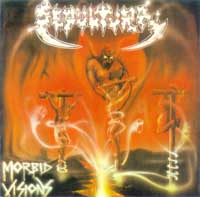Sepultura - Morbid Visions/Bestial Devastation
Review: Raw motion music in the postapocalyptic style of Slayer and Possessed using the syncretism of atmospheric riff patternings in a style reminiscent of Massacra, these two EPs of seminal material from Sepultura establish the distinctive sound which was to dominate the South American scene for two generations, building empires of structure from the simple differences and thunder of textural dynamic disparity in the directional information coded through whipping power chord music. At explosive speeds this music recombines at the command of gutteral, primitive vocals and bludgeon-simple percussion which maintains a fury of emphasis forward while checking structure as necessary and maintaining a simple, sensual presence.
Belligerent in conception songs are simple in execution following the Slayer style of staggered introduction of theme through opposite halves layered across strings and percussion in a delivery that proceeds each major thematic change with introductory motion, then breaks into a component of theme and its fragmentary complements before reconstructing a primary idea from the tone-centric progression as phrases develop to articulation. Dynamic varies despite constant tremelo strumming of notes and chords at paces synchronized with approach to the internal harmonies Doppleresquely arranged at prime rhythms throughout each piece; progression in dynamics is sculpted wholly from the type of motion (texture + velocity toward/away from root note) crafted in ripping waves of guitar sound and apocalyptic collisions of vocal and stringblast noise.
Satanic and morbid occultist imagery pervade the lyrics and composition of this release, which in the style which bands from Havohej to Beherit and Darkthrone employ, subjugates the ridiculous to serve the abstracted lifestyle determinations the visions of mythos and living mysticism evoke. Muscular in its recombinant structure in both sum of phrases and the construction of phrases as minimalist motion of structure around central tones, these dark hymns inspired generations of metalheads and after some delayed propagation following their respective releases in 1984-85 are recognized as foundational to the embryonic death metal genre.

